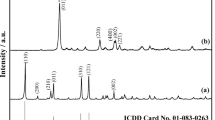Abstract
Conventional thermoanalytical curves provide little information on the thermal decomposition of Ca(NO3)2 · CO(NH2)2 · 3 H2O. In contrast from quasi-isothermal-quasi-isobaric thermogravimetric curves the mechanism can easily be interpreted. After the complex melts at 60°C, the solution formed is weight constant up to 135°C in the labyrinth crucible. The solution begins to boil at 135°C and gradually loses water, its boiling point increasing. The solution becomes saturated at 200°C. Thereafter, Ca(NO3)2 · CO(NH2)2 separates out while the boiling point does not change. After the departure of the water, the CO(NH2)2 immediately decomposes and Ca(NO3)2 remains.
In an open crucible the above transformation is complicated by decomposition of typeAB (s)=A (s)+B (g) solution “evaporation” “drying” of solid residue, surface crust formation, etc. In conventional thermoanalysis the latter processes accompany the above processes (melting-solution formation-loss of water during boiling) which hampers interpretation of the conventional curve.
Zusammenfassung
Herkömmliche thermoanalytische Kurven liefern wenig Informationen über die thermische Zersetzung von Ca(NO3)2 · CO(NH2)2 · 3 H2O. Quasi-isotherme/quasi-isobare thermogravimetrische Kurven dagegen ermöglichen leicht eine Interpretation des Mechanismus. Nach dem Schmelzen des Komplexes bei 60°C bleibt das Gewicht der Lösung im Labyrinthtiegel bis 135°C konstant. Die Lösung beginnt bei 135°C zu sieden und verliert zunehmend an Wasser, wobei der Siedepunkt ansteigt. Die Lösung erreicht den Sättigungspunkt bei 200°C. Danach scheidet sich Ca(NO3)2 · CO(NH2)2 ohne weitere Veränderung des Siedepunktes ab. Nach Entfernung des Wassers zersetzt sich das CO(NH2)2 sofort und Ca(NO3)2 bleibt zurück.
In einem offenen Tiegel wird die obige Umwandlung durch Zersetzung des TypesAB (s)= =A (s)+B(g), durch “Verdampfung” der Lösung, durch “Trocknung des festen Rückstandes”, durch Oberflächenverkrustung usw. kompliziert. Diese Prozesse begleiten bei der herkömmlichen Thermoanalyse die oben erwähnten Vorgänge (Schmelzen-Lösungsbildung-Wasserverlust durch Sieden), wodurch die Interpretation der herkömmlichen Kurven erschwert wird.
Резюме
Обычные термоаналит ические кривые термического разлож ения аддукта Са(NО3)2·СО(NН2)2·3 Н2O мало и нформативны. Наоборо т, на основе квазиизотерм и-ческих и квазиизобарных тер могравиметрических кривых, механизм разл ожения может быть легко интерпрет ирован. После плавлен ия комплекса при 60°С обра зующийся в тигле лабиринтного типа ра створ остается посто янным по весу до 135°С. Раствор на чинает кипеть при 135°С и по мере потер и воды увеличивается точка кипения. Раствор стан овится насы-щенным при 200°С. С этого времен и, Са(NО3)2 · СО(NН2)2 отделяется при неизм енной точке кипения. После о тделения воды, мочеви на разлагается и остает ся только нитрат кальцин. В открытом ти гле, вышеприведенное превращение осложня ется разложением типа ABpacтв.=Apacтв + Bpacтв., “вып ариванием” раствора, “высушиванием” твер дого остатка, образование м поверхностной корк и и т.п. При обычном термоанализ е последние процессы сопровожда ются вышеприведенны ми процессами: плавлени е — образование раствора — потеря вод ы во время кипения, что затрудняет интерпре тацию традиционной кривой.
Similar content being viewed by others
References
W. Gryl and M. Hulle, Przem. Chem., 46 (1967) 34.
M. Sarnowski, J. Krawczyk, J. Zygadle and J. Scienska, Przem. Chem., 11 (1955) 228.
O. K. Janatieva, Je. Je. Astafieva and W. T. Orlova, Z. Neorg. Chim., 15 (1970) 2813.
J. M. Kaganskij, G. S. Mychla, W. W. Chalamova and A. S. Cherkova, Sb, Statiej “Issledovanija v olblasti chimii i technologii mineralnych solej i okislov”, M.-T. Nauka, 1965, p. 5.
O. K. Janatieva, Je. Je. Ostafieva and W. T. Orlova, Z. Neorg. Chim., 15 (1969) 1999.
I. Piechocinska and K. Jucha, Przem. Chem., 49 (1979) 32.
F. Paulik, J. Paulik and K. Wieczorek-Ciurowa, J. Thermal Anal., 28 (1983) 395.
L. Lebioda, Roczniki Chemii, 46 (1972) 373.
I. Piechocinska and K. Wieczorek-Ciurova, Roczniki Chemii, 45 (1971) 1125.
W. T. Orlova, Je. Je. Astafieva and O. K. Janatieva, Uczenyje zapiski, vyp 81, ser. Chim. Nauk. Mold. Gosud. Univ. Saransk, 1971, p. 46.
F. Paulik and J. Paulik, J. Thermal Anal., 5 (1973) 252.
F. Paulik and J. Paulik, Thermochim. Acta, 4 (1972) 189.
J. Paulik and F. Paulik, Simultaneous thermoanalytical examination by means of the derivatograph in series Wilson-Wilson Comprehensive Analytical Chemistry, vol. XII, Ed. G. Svehla, part A., Ed. W. W. Wendlandt, Elsevier Sci. Publ. Comp. Amsterdam, 1981.
K. Wieczorek-Ciurowa, I. Piechocinska, F. Paulik and J. Paulik, Hungarian Symposium on Thermal Analysis, Budapest, Hungary, 1981. Abstracts of papers, Workbook Ed. I. Buzás, Hung. Ac. Sci., Budapest.
J. Paulik, F. Paulik and M. Arnold, J. Thermal Anal., in press.
Author information
Authors and Affiliations
Additional information
The authors are indebted to Prof. E. Bulewicz and Prof. E. Pungor for valuable discussions.
They thank Mrs. M. Kiss and Miss I. Fábián for technical assistance.
Rights and permissions
About this article
Cite this article
Wieczorek-Ciurowa, K., Paulik, J. & Paulik, F. Thermogravimetric study of dehydration of Ca(NO3)2 · CO(NH2)2 · 3 H2O under quasi-isothermal-quasi-isobaric conditions. Journal of Thermal Analysis 28, 405–411 (1983). https://doi.org/10.1007/BF01983275
Received:
Issue Date:
DOI: https://doi.org/10.1007/BF01983275




